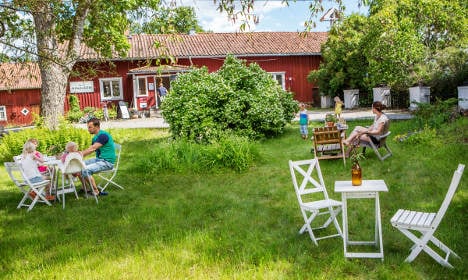White Guide, the foodie group that annually lists the Nordic country's top restaurants and bars, and which Swedes like to think of as their very own Guide Michelin – has released its pick of Sweden's top cafés.
If you want to jump on the world's rapidly growing 'Swedish fika' trend of sitting down for a coffee and cake alone, with friends or work colleagues, apparently Annas Hembageri in Mariefred is the place to go.
Located in the central Swedish town by Lake Mälaren, about 50 kilometres west of Stockholm, the café claimed the top spot at the awards late on Monday. It is run by Robert and Anna Schweiz, a married couple who started the business after leaving behind their hectic lawyer and economist careers in the capital.
“For turning that little red cottage into a genuinely warm experience where craftsmanship and a sense of service brings joy to the constantly returning customers,” read the White Guide jury's motivation.
“Amazing,” Robert Schweiz commented the win. “We're trying to take in the praise as much as we can.”
WATCH: Fika is a coffee break, with emphasis on 'break'
What's fika? Well, if you've lived in Sweden for more than five minutes you'll be well aware of the almost-daily coffee-and-something-sweet routine. But the phenomenon has also been going global in recent years, with more and more Nordic coffee shops popping up abroad.
On home turf, the intimate, low-key tradition has put up a good fight against big chains cashing in. US coffee giant Starbucks did not open its first café in the country until 2010. It now owns 17 stores across Sweden.
However, Swedish chain Espresso House owns 56.8 percent of the café market share, closely followed by Waynes Coffee at 21.4 percent, according to Delfi Fastfoodguide, which puts together statistics on the food and restaurant markets.
“You can tell that the big café chains are growing. But at the same time there's an explosion of new, cozy little cafés,” said Schweiz.
“That's what the audience wants. At the same time the big chains are going to stay at the central addresses where we are not even able to rent premises.”
Meanwhile, Nygrens Café in Alingsås, which has the most cafés per capita in Sweden, took home the award in the Fika Place of the Year category.
“Our fika tradition in Alingsås dates back until a time when we had a lot of industries in the town and workers didn't have time to bake themselves, so they ate out at cafés,” co-owner Sandra Grönkvist told The Local of the centuries-old tradition earlier this spring.
Winners in all White Guide 2016 café categories
Café of the Year: Annas Hembageri, Mariefred
Patisserie of the Year: Conditori Nordpolen, Vara
Coffee Bar of the Year: Kale'i Kaffe & Mat, Gothenburg
Shooting Star of the Year: Älskade Traditioner, Stockholm
Sustainable Café of the Year: Hornsuddens Ekocafé, Strängnäs
Worth-a-trip of the Year: R C Chocolat, Sigtuna
Fika Place of the Year: Nygrens Café, Alingsås
Bakery of the Year: Bageri Petrus, Stockholm



 Please whitelist us to continue reading.
Please whitelist us to continue reading.